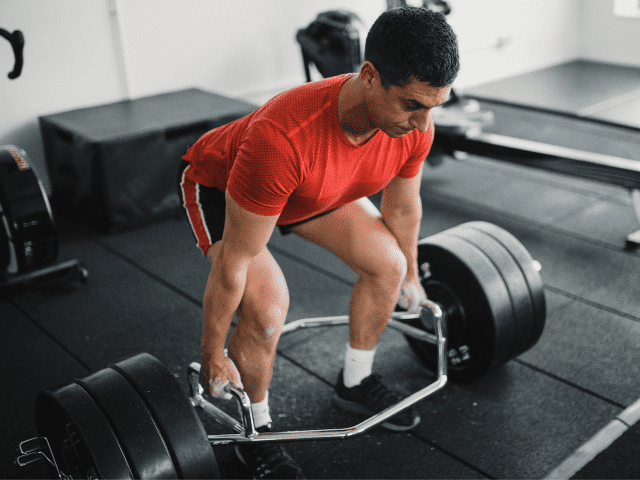Rack Pulls (How To, Muscles Worked, Benefits)
Rack Pulls (also known as Pin Pulls or Partial Deadlifts) are a deadlift variation done in a power rack. Because the lifter is starting with the bar elevated off the ground, Rack Pulls can be done with as much and often times more weight than from the floor.
Rack Pulls are also an excellent alternative for athletes with limited mobility and struggle with obtaining a good starting position from the floor. Rack Pulls can substitute for Deadlifts while they work to improve flexibility and mobility.
In this guide, I will teach you how to do Rack Pulls including important coaching tips, muscles worked and a few alternatives.
How To Do Rack Pulls
Equipment Needed
- Barbell
- Weight Plates (either iron or bumper will work okay)
- Power Rack (or lifting blocks)
- Lifting Straps (optional)
Muscles Worked
Rack Pulls, like Deadlifts, are a total body exercise. Almost every muscle group in the body is utilized during this exercise.
How To
- Set a barbell on the power rack safety pins set up around mid-shin*.
- Place the feet roughly shoulder-width apart.
- Slightly turn their feet outward (engaging the glutes).
- The athlete should hinge at the waist and bend at the knee simultaneously until they can comfortably squeeze the barbell with both hands pronated**.
- As the athlete pulls themselves down into their setup position, they should maintain a neutral head posture, with their eyes fixed on something about 1-2 feet in front of them.
- Take a deep breath to brace the abdominal muscles.
- In the final setup position, the athlete should pull their chest up, and shoulder blades back, while still maintaining a brace in their abdominal muscles and ready to lift.
- Start the pull by driving the feet through the floor and driving the hips forward, keeping tension in the abdomen and upper back (DO NOT ROUND YOUR BACK), maintaining the barbell over the midfoot, the lifter stands tall with the barbell, and locks the repetition in.
- Lower back down to the starting position under control. Make sure to maintain your braced core while lowering as well.
Coaching Points
*Rack Pulls are generally done with the bar starting around mid-shin, although technically the bar can be placed anywhere up or down the leg and it would still be a Rack Pull.
**An alternated grip – one hand pronated, one hand supinated – can also be used when doing Rack Pulls to help aid the grip. Using lifting straps is another option if grip is becoming a limiting factor when using heavy weight.
Because the plates are not actually touching the ground during Rack Pulls, there is no difference regarding what kind of plates you use.
Lifting blocks, used more commonly by Olympic weightlifters, is an acceptable substitution for a power rack when doing Rack Pulls.
Benefits
Rack pulls are a variation of the deadlift exercise that can help to improve strength and muscle development in the upper and lower back, as well as the glutes, hamstrings, and quads. They can also help to improve overall grip and forearm strength.
Rack pulls are often used to help lifters who may be struggling to perform traditional deadlifts due to flexibility or mobility limitations. In addition, they can be a useful exercise for targeting specific muscles or muscle groups that may need extra work.
How Many Reps?
Rack Pulls are a lower body compound strength-building exercise. From a programming standpoint, they should be treated no differently than regular Deadlifts. Recommended rep ranges are 3 to 5 sets of 2 to 5 reps each set.
Higher rep ranges can be used for the purpose of building muscular endurance toward the beginning of an off-season cycle. Intensities (percentages used) should be lowered to reflect the higher rep sets.
Rack Pull Alternatives
Need an alternative for Rack Pulls? Here are a few exercises that you may be able to use as a replacement.
Want more options? Here are my 10 favorite Rack Pull alternatives.
Trap Bar Deadlifts

If you have a Trap Bar (also called a hex bar), then Trap Bar Deadlifts can make an excellent substitution for Rack Pulls. From a movement standpoint, they’re both Deadlift variations and are both essentially the exact same movement pattern.
What makes Trap Bar Deadlift an especially close alternative is that Trap Bars have elevated handles that (depending on the brand of the bar) will also elevate the starting point higher than a typical Deadlift.
Pro Tip: Unlike barbells, Trap Bars can vary substantially in weight. Keep this in mind if you’re working with a bar that you’re not familiar with.
Dumbbell Romanian Deadlift (RDL)
If you don’t have a barbell, Dumbbell RDLs can be an excellent alternative exercise for Rack Pulls. You probably won’t be able to work as heavy, but Dumbbell RDLs are an excellent movement for developing the posterior chain.
More Links and Info
If you’d like to see more lower body exercises, head over to the Lower Body Lifts section of our Exercise Library. There you’ll find dozens of movements to help you build strong legs, all with step-by-step instructions.

